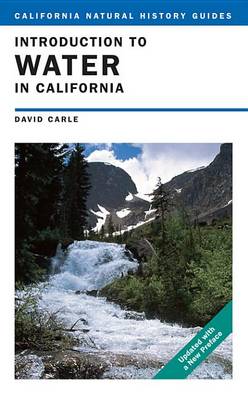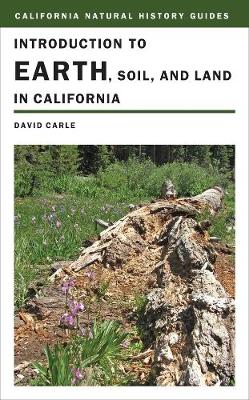California Natural History Guides
4 primary works
Book 76
It takes 8 gallons of water to grow a tomato; 616 gallons to make a burger patty. In fact, the food each of us consumes per day represents an investment of 4,500 gallons of water, according to the California Farm Bureau. In this densely populated state where it rains only six months out of the year, where does all that water come from? This thoroughly engaging, concise book tells the story of California's most precious resource, tracing the journey of water in the state from the atmosphere to the snowpack to our faucets and foods. Along the way, we learn much about California itself as the book describes its rivers, lakes, wetlands, dams, and aqueducts and discusses the role of water in agriculture, the environment, and politics. Essential reading for a state facing the future with an already overextended water supply, this fascinating book shows that, for all Californians, every drop counts.
* Features 137 color photographs and 27 color maps
* Includes a table "Where Does Your Water Come From?" that answers the question for 315 California cities and towns
* Provides up-to-date information on water quality in California, covering such timely topics as Giardia, groundwater contamination, fluoride, and the bottled-water phenomenon
A book in the Californians and Their Environment subseries, dedicated to understanding human influences on the state's ecology and natural resources
* Features 137 color photographs and 27 color maps
* Includes a table "Where Does Your Water Come From?" that answers the question for 315 California cities and towns
* Provides up-to-date information on water quality in California, covering such timely topics as Giardia, groundwater contamination, fluoride, and the bottled-water phenomenon
A book in the Californians and Their Environment subseries, dedicated to understanding human influences on the state's ecology and natural resources
Book 87
What is air? Why is the sky blue? Why do people react favorably to mountain or sea air? How does desert air differ from the air of California's Central Valley? How is air pollution affecting plants and animals? This book is a unique guide to the air we breathe in California. More than a natural history guide, it approaches this fascinating topic by recognizing the overwhelming role played by humans in the story of California's air. In a highly engaging style, David Carle explains daily weather patterns, seasonal climate, characteristic winds, and sky phenomena. He explores air as the gases in our atmosphere, but also considers the aspects of air that influence all of our senses - its taste, smell, feel, and look. The guide discusses California's history of air quality management, air pollution and its effect on humans and the environment, and the technological and individual measures needed to address these challenges. The book also functions as a handbook for more environmentally conscious living by providing information on alternative energy sources for consumers and tips for cleaner running cars.
It features 80 color photographs, 23 figures, 18 maps and covers regional differences of topography, weather, and the character of the air in California's fifteen designated air basins. It includes a field guide to the sky, explaining color and light, clouds and wind, and the nature of flight and addresses issues surrounding global climate change in California. This is a book in the "Californians and Their Environment Sub-Series", dedicated to understanding human influences on the state's ecology and natural resources.
It features 80 color photographs, 23 figures, 18 maps and covers regional differences of topography, weather, and the character of the air in California's fifteen designated air basins. It includes a field guide to the sky, explaining color and light, clouds and wind, and the nature of flight and addresses issues surrounding global climate change in California. This is a book in the "Californians and Their Environment Sub-Series", dedicated to understanding human influences on the state's ecology and natural resources.
Book 95
What is fire? How are wildfires ignited? How do California's weather and topography influence fire? How did the California Indians use fire? In the spirit of his highly acclaimed "Introduction to Air in California" and "Introduction to Water in California", David Carle now turns to another fundamental element of the natural world, giving a fascinating and concise view of this complex topic. His clearly written, dramatically illustrated book will help Californians, including the millions who live near naturally flammable wildlands, better understand their own place in the state's landscape. Carle covers the basics of fire ecology; looks at the effects of fire on wildlife, soil, water, and air; discusses firefighting organizations and land management agencies; explains current policies; and, explores many other topics. This title features: 91 color illustrations and 15 maps; tips on what to do before, during, and after fires; an overview of major wildfires in California's history; and, a discussion of the effect of climate change on fires in natural landscapes.
This is a book in the "Californians and Their Environment" subseries, dedicated to understanding human influences on the state's ecology and natural resources.
This is a book in the "Californians and Their Environment" subseries, dedicated to understanding human influences on the state's ecology and natural resources.
Book 101
Following his acclaimed guides to air, fire, and water, David Carle now offers a fascinating exploration of one more primary element of the natural world - the land beneath our feet. From earthworms and earthquakes to Earth Day, this concise, engaging guide is a multifaceted primer on the literal foundation of California's environment. Carle tells how soil ecosystems function, discusses what lives in the soil, and examines various soil types. He then turns to the relationship between humans and the land, and investigates the various uses and abuses that land in California endures: large scale agriculture, mining, and development, as well as fires, floods, and erosion. The guide also details the history of land use in the state, making it an essential resource for understanding our total reliance on soil, the marvelous substrate that is the basis of life. It covers the entire state, including California's wildlands, farmland, cities, and landfills. It assesses California's ecological footprint on planet Earth. It discusses many different life forms found in soil, including bacteria, fungi, insects, and mammals.
It features 92 color photographs and 18 maps A book in the Californians and Their Environment subseries, dedicated to understanding human influences on the state's ecology and natural resources.
It features 92 color photographs and 18 maps A book in the Californians and Their Environment subseries, dedicated to understanding human influences on the state's ecology and natural resources.


